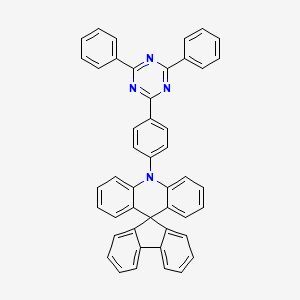SpiroAC-TRZ
Safety Information
Hazard Statements
Precautionary Statements
Pictograms
Properties
| Signal Word | Warning |
Product Description
SpiroAC–TRZ, or 10-(4-(4,6-diphenyl-1,3,5-triazin-2-yl)phenyl)-10H-spiro[acridine-9,9'-fluorene], is a unique chemical compound known for its distinctive structure. It combines elements of acridine and fluorene, creating a complex molecular architecture. This compound exhibits interesting photophysical properties, including fluorescence and phosphorescence, which can be leveraged in various applications. Its structure allows for potential use in advanced materials science, particularly in the development of organic light-emitting diodes (OLEDs) and other optoelectronic devices. Additionally, its stability and reactivity profile makes it an attractive candidate for further research and application in chemistry and material sciences.
Application
SpiroAC–TRZ finds its primary application in the field of optoelectronics due to its fluorescent and phosphorescent properties. Its ability to emit light under certain conditions makes it suitable for use in OLED displays, offering high efficiency and color accuracy. Furthermore, its chemical stability and unique electronic structure suggest potential uses in sensor technology, where it could serve as a sensitive probe for detecting specific molecules or ions. Additionally, researchers exploring new materials for energy conversion processes, such as solar cells, might find SprioAC–TRZ useful for its potential to absorb and convert sunlight efficiently. Lastly, its intriguing properties make it a subject of interest for academic studies aiming to understand and manipulate molecular interactions for practical applications.
Articles:
- Effect of TADF Assistance on Performance Enhancement in Solution Processed Green Phosphorescent OLEDs
Publication Date: 2 April 2021
Ewelina Witkowska, Gabriela Wiosna-Salyga, Ireneusz Glowacki,Tung-Huei Ke, Pawel Malinowski and Paul Heremans
https://doi.org/10.3390/polym13071148
- Tri-Spiral Donor for High Efficiency and Versatile Blue Thermally Activated Delayed Fluorescence Materials
Publication Date: 13 June 2019
Dr. Wei Li, Binbin Li, Dr. Xinyi Cai, Lin Gan, Zhida Xu, Wenqi Li, Dr. Kunkun Liu, Dr. Dongcheng Chen, Prof. Shi-Jian Su
https://doi.org/10.1002/ange.201904272
- Phenazasiline/Spiroacridine Donor Combined with Methyl-Substituted Linkers for Efficient Deep Blue Thermally Activated Delayed Fluorescence Emitters
Publication Date: January 22, 2019
Seung-Je Woo, Youheon Kim, Soon-Ki Kwon, Yun-Hi Kim, Jang-Joo Kim
